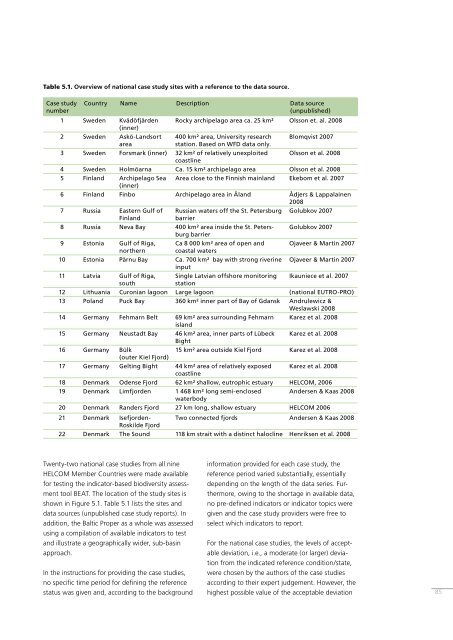BSEP116B Biodiversity in the Baltic Sea - Helcom
BSEP116B Biodiversity in the Baltic Sea - Helcom
BSEP116B Biodiversity in the Baltic Sea - Helcom
Create successful ePaper yourself
Turn your PDF publications into a flip-book with our unique Google optimized e-Paper software.
Table 5.1. Overview of national case study sites with a reference to <strong>the</strong> data source.<br />
Case study<br />
number<br />
Country Name Description Data source<br />
(unpublished)<br />
1 Sweden Kvädöfjärden<br />
(<strong>in</strong>ner)<br />
2 Sweden Askö-Landsort<br />
area<br />
Rocky archipelago area ca. 25 km² Olsson et. al. 2008<br />
400 km² area, University research<br />
station. Based on WFD data only.<br />
Blomqvist 2007<br />
3 Sweden Forsmark (<strong>in</strong>ner) 32 km² of relatively unexploited Olsson et al. 2008<br />
coastl<strong>in</strong>e<br />
4 Sweden Holmöarna Ca. 15 km² archipelago area Olsson et al. 2008<br />
5 F<strong>in</strong>land Archipelago <strong>Sea</strong> Area close to <strong>the</strong> F<strong>in</strong>nish ma<strong>in</strong>land Ekebom et al. 2007<br />
(<strong>in</strong>ner)<br />
6 F<strong>in</strong>land F<strong>in</strong>bo Archipelago area <strong>in</strong> Åland Ådjers & Lappala<strong>in</strong>en<br />
2008<br />
7 Russia Eastern Gulf of<br />
F<strong>in</strong>land<br />
Russian waters off <strong>the</strong> St. Petersburg<br />
barrier<br />
8 Russia Neva Bay 400 km² area <strong>in</strong>side <strong>the</strong> St. Petersburg<br />
barrier<br />
9 Estonia Gulf of Riga,<br />
nor<strong>the</strong>rn<br />
Ca 8 000 km² area of open and<br />
coastal waters<br />
10 Estonia Pärnu Bay Ca. 700 km² bay with strong river<strong>in</strong>e<br />
<strong>in</strong>put<br />
11 Latvia Gulf of Riga,<br />
south<br />
S<strong>in</strong>gle Latvian offshore monitor<strong>in</strong>g<br />
station<br />
Golubkov 2007<br />
Golubkov 2007<br />
Ojaveer & Mart<strong>in</strong> 2007<br />
Ojaveer & Mart<strong>in</strong> 2007<br />
Ikauniece et al. 2007<br />
12 Lithuania Curonian lagoon Large lagoon (national EUTRO-PRO)<br />
13 Poland Puck Bay 360 km² <strong>in</strong>ner part of Bay of Gdansk Andrulewicz &<br />
Weslawski 2008<br />
14 Germany Fehmarn Belt 69 km² area surround<strong>in</strong>g Fehmarn Karez et al. 2008<br />
island<br />
15 Germany Neustadt Bay 46 km² area, <strong>in</strong>ner parts of Lübeck Karez et al. 2008<br />
Bight<br />
16 Germany Bülk<br />
15 km² area outside Kiel Fjord Karez et al. 2008<br />
(outer Kiel Fjord)<br />
17 Germany Gelt<strong>in</strong>g Bight 44 km² area of relatively exposed Karez et al. 2008<br />
coastl<strong>in</strong>e<br />
18 Denmark Odense Fjord 62 km² shallow, eutrophic estuary HELCOM, 2006<br />
19 Denmark Limfjorden 1 468 km² long semi-enclosed Andersen & Kaas 2008<br />
waterbody<br />
20 Denmark Randers Fjord 27 km long, shallow estuary HELCOM 2006<br />
21 Denmark Isefjorden- Two connected fjords Andersen & Kaas 2008<br />
Roskilde Fjord<br />
22 Denmark The Sound 118 km strait with a dist<strong>in</strong>ct halocl<strong>in</strong>e Henriksen et al. 2008<br />
Twenty-two national case studies from all n<strong>in</strong>e<br />
HELCOM Member Countries were made available<br />
for test<strong>in</strong>g <strong>the</strong> <strong>in</strong>dicator-based biodiversity assessment<br />
tool BEAT. The location of <strong>the</strong> study sites is<br />
shown <strong>in</strong> Figure 5.1. Table 5.1 lists <strong>the</strong> sites and<br />
data sources (unpublished case study reports). In<br />
addition, <strong>the</strong> <strong>Baltic</strong> Proper as a whole was assessed<br />
us<strong>in</strong>g a compilation of available <strong>in</strong>dicators to test<br />
and illustrate a geographically wider, sub-bas<strong>in</strong><br />
approach.<br />
In <strong>the</strong> <strong>in</strong>structions for provid<strong>in</strong>g <strong>the</strong> case studies,<br />
no specific time period for def<strong>in</strong><strong>in</strong>g <strong>the</strong> reference<br />
status was given and, accord<strong>in</strong>g to <strong>the</strong> background<br />
<strong>in</strong>formation provided for each case study, <strong>the</strong><br />
reference period varied substantially, essentially<br />
depend<strong>in</strong>g on <strong>the</strong> length of <strong>the</strong> data series. Fur<strong>the</strong>rmore,<br />
ow<strong>in</strong>g to <strong>the</strong> shortage <strong>in</strong> available data,<br />
no pre-def<strong>in</strong>ed <strong>in</strong>dicators or <strong>in</strong>dicator topics were<br />
given and <strong>the</strong> case study providers were free to<br />
select which <strong>in</strong>dicators to report.<br />
For <strong>the</strong> national case studies, <strong>the</strong> levels of acceptable<br />
deviation, i.e., a moderate (or larger) deviation<br />
from <strong>the</strong> <strong>in</strong>dicated reference condition/state,<br />
were chosen by <strong>the</strong> authors of <strong>the</strong> case studies<br />
accord<strong>in</strong>g to <strong>the</strong>ir expert judgement. However, <strong>the</strong><br />
highest possible value of <strong>the</strong> acceptable deviation<br />
85

















